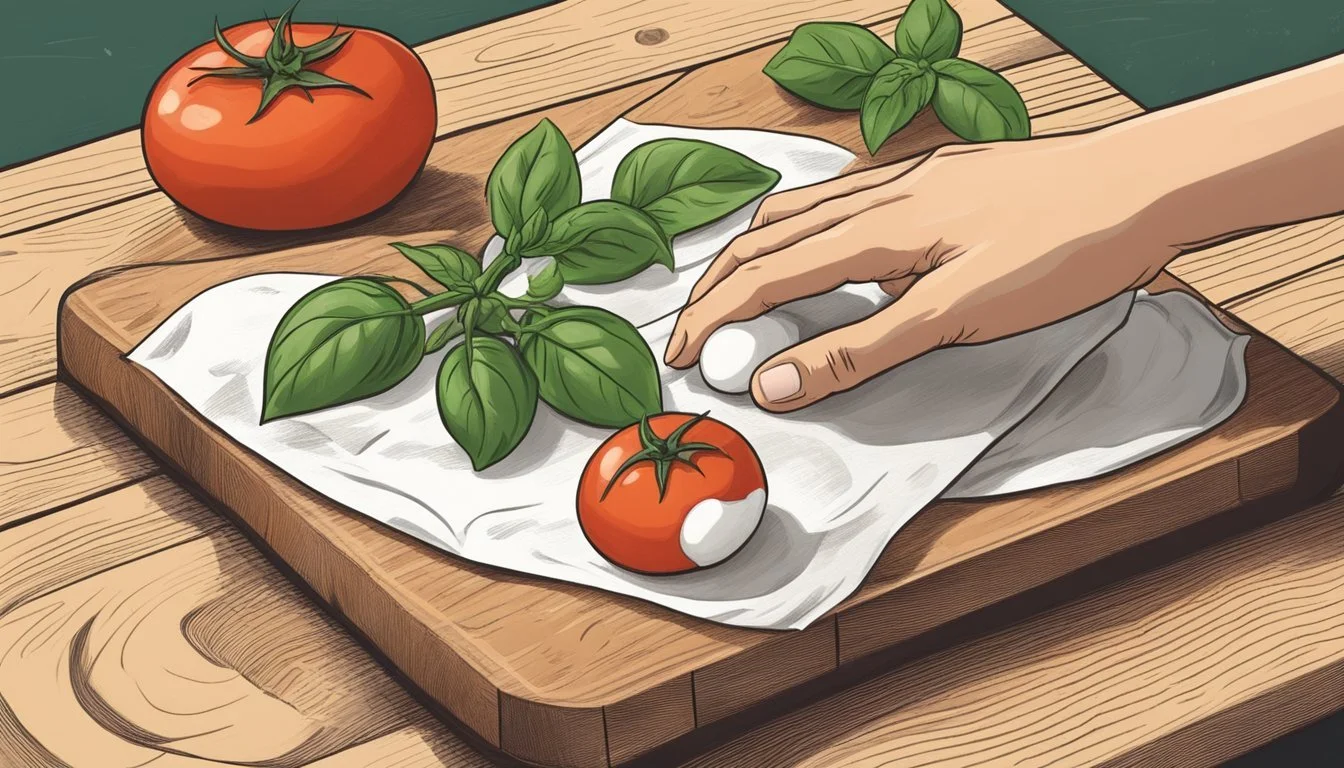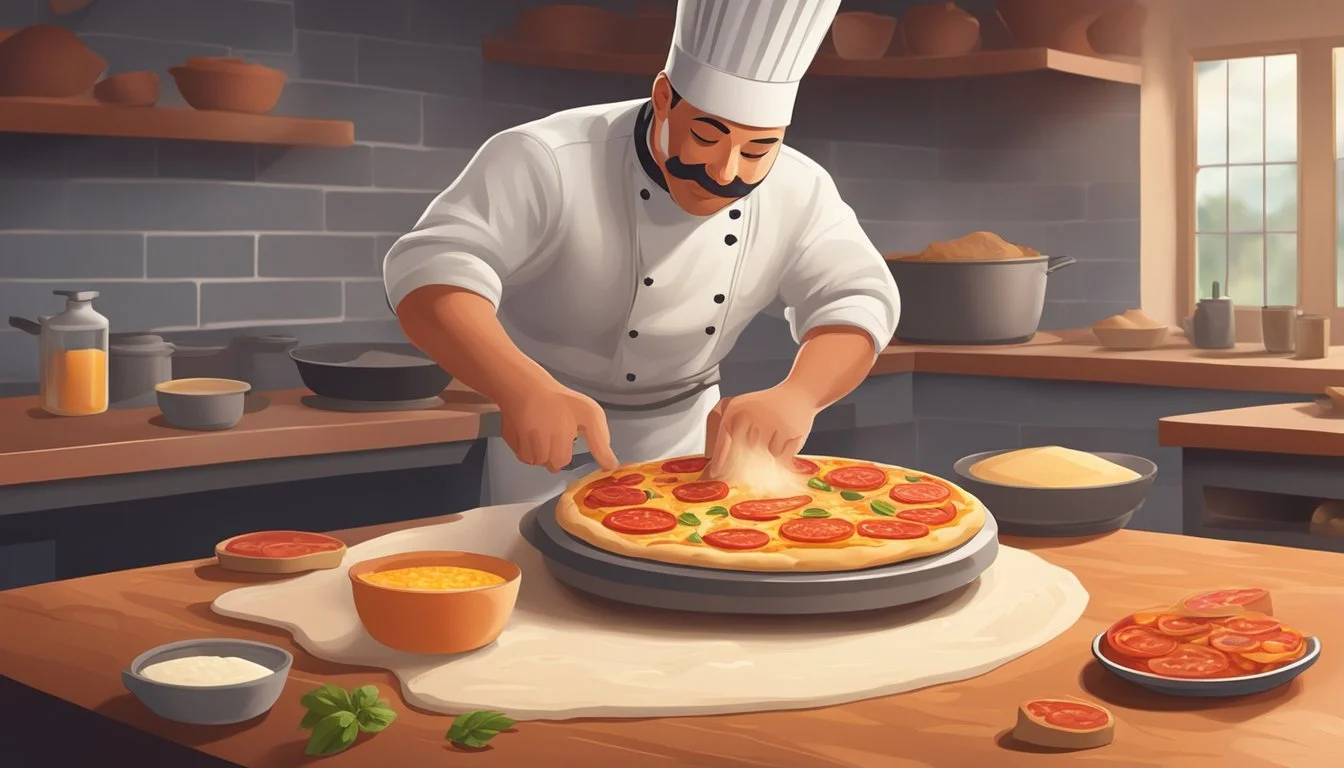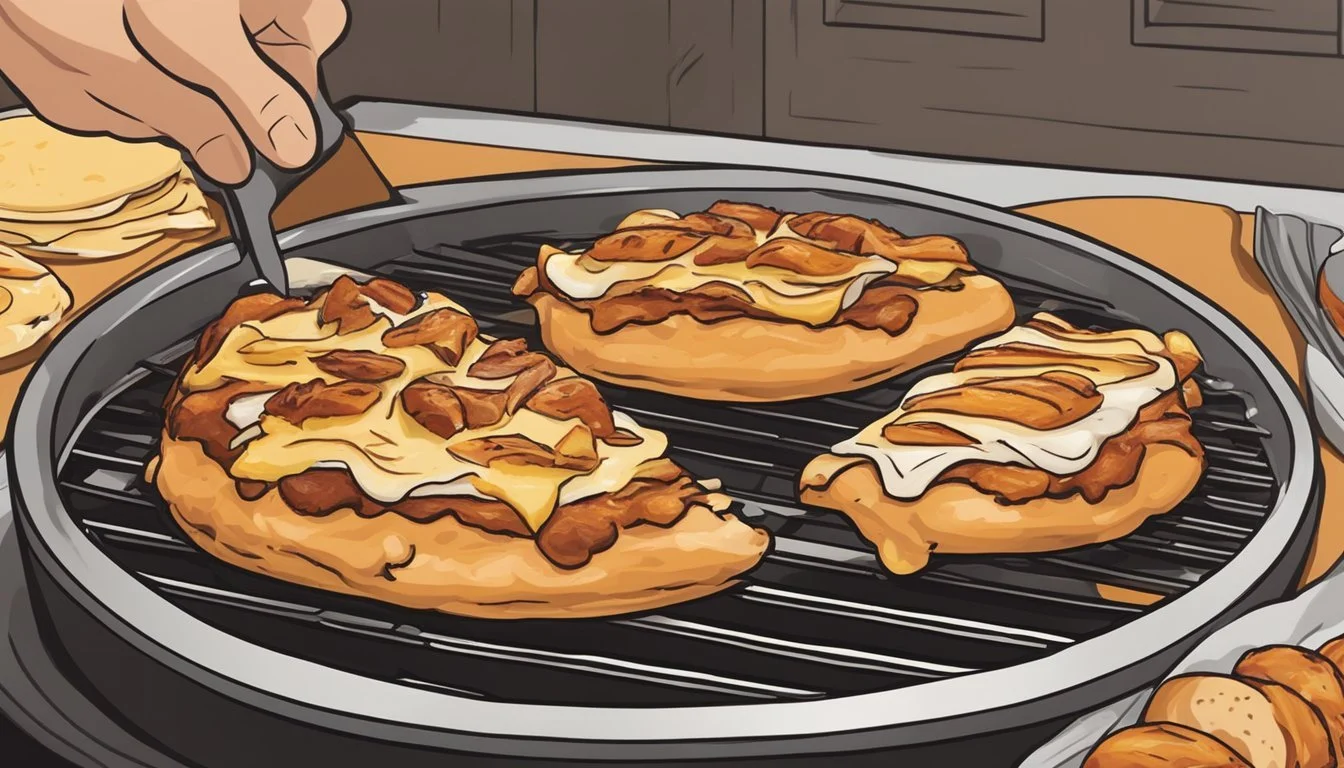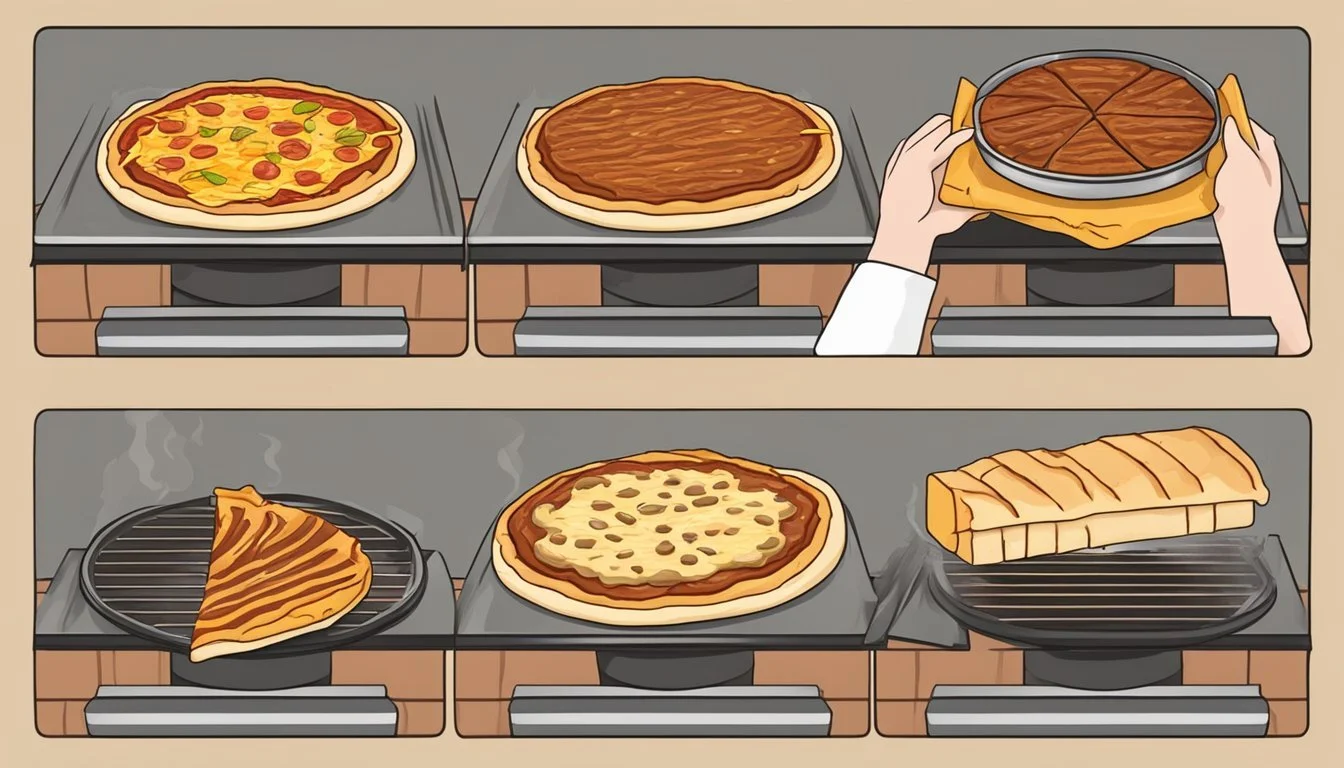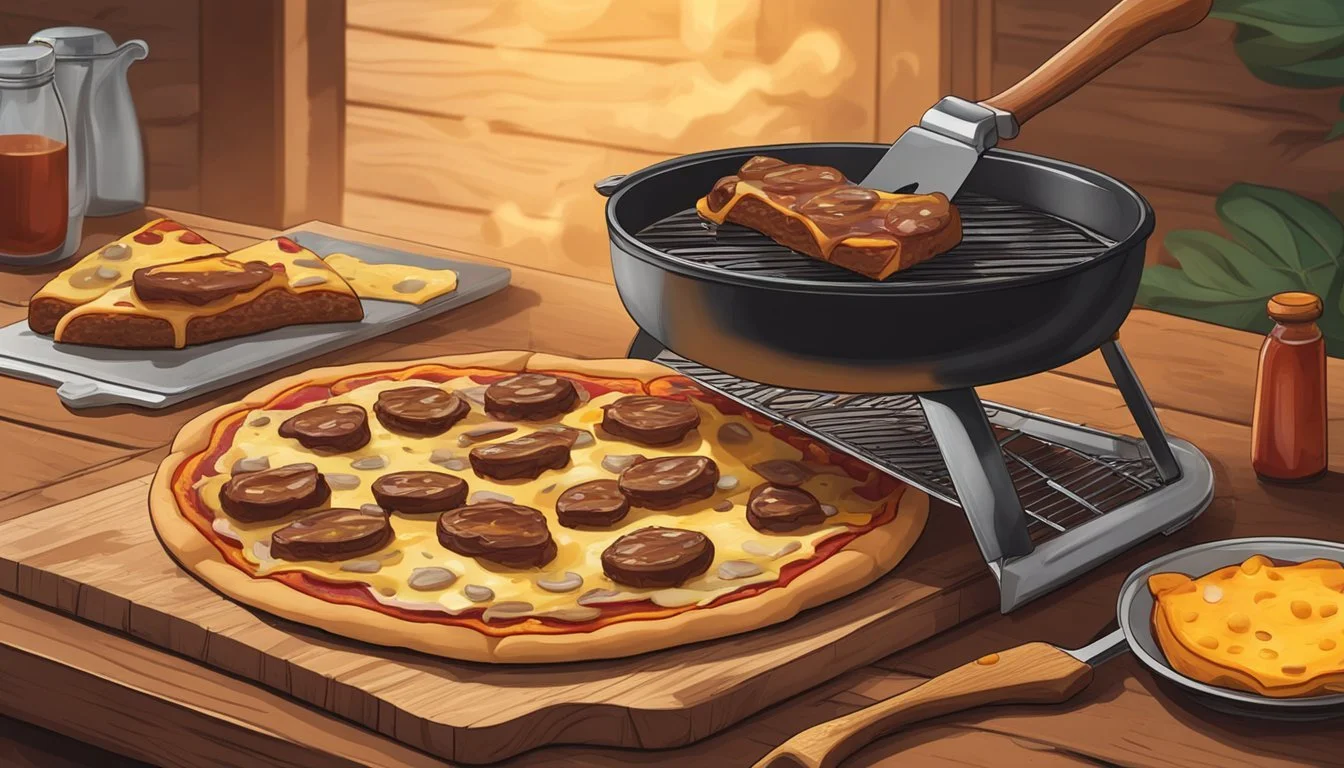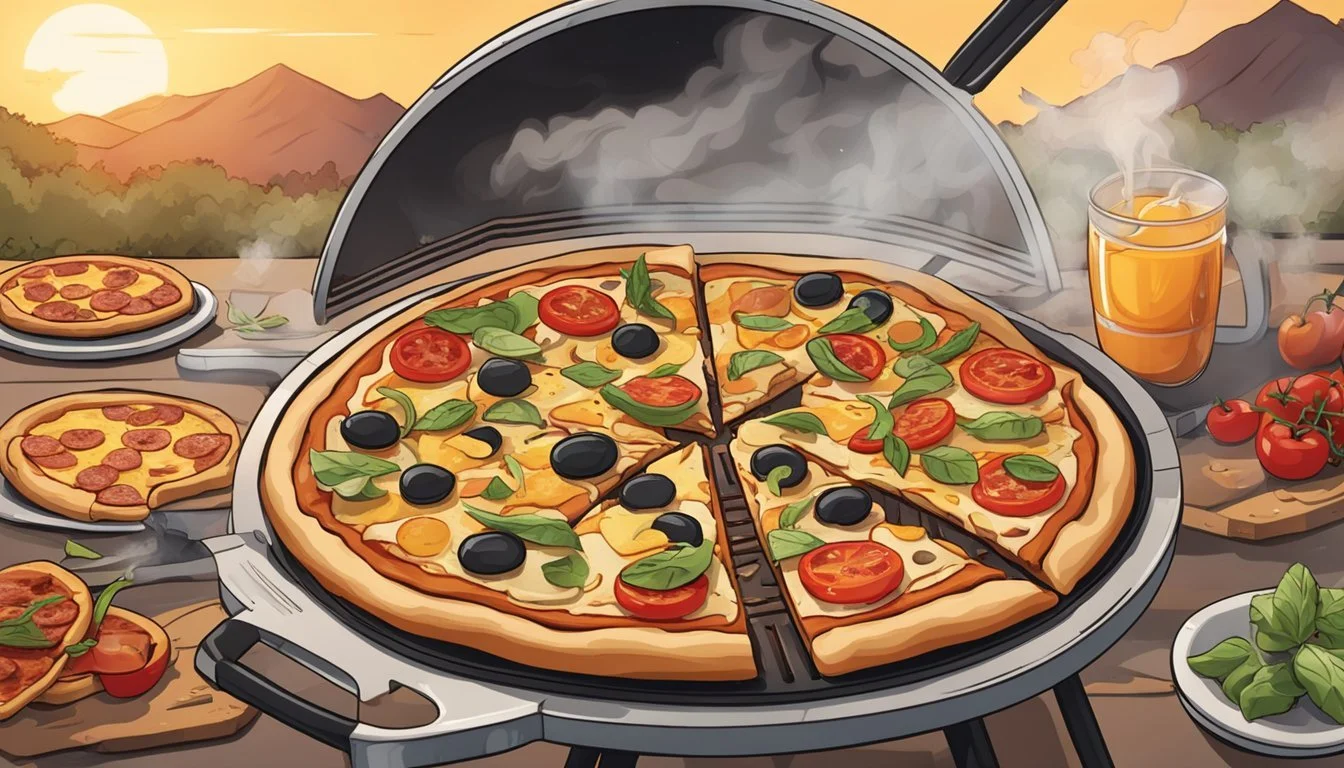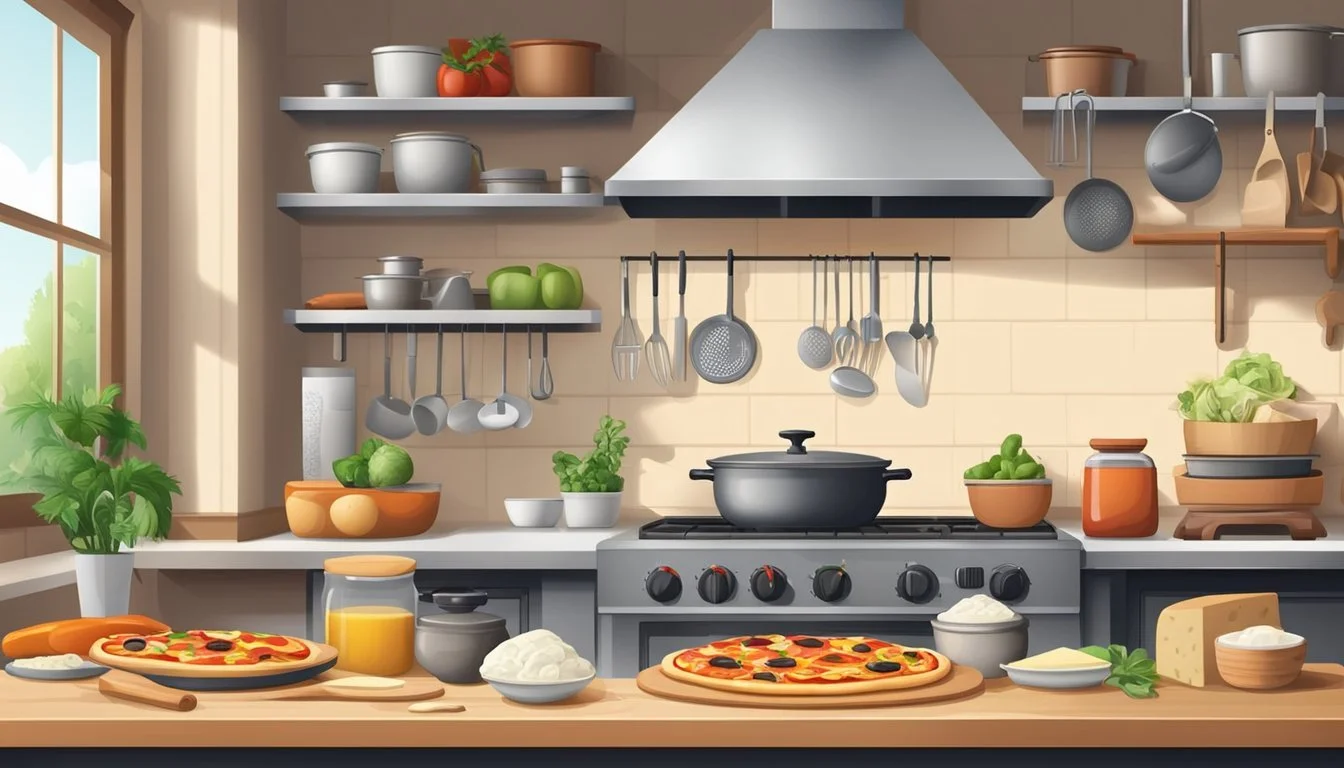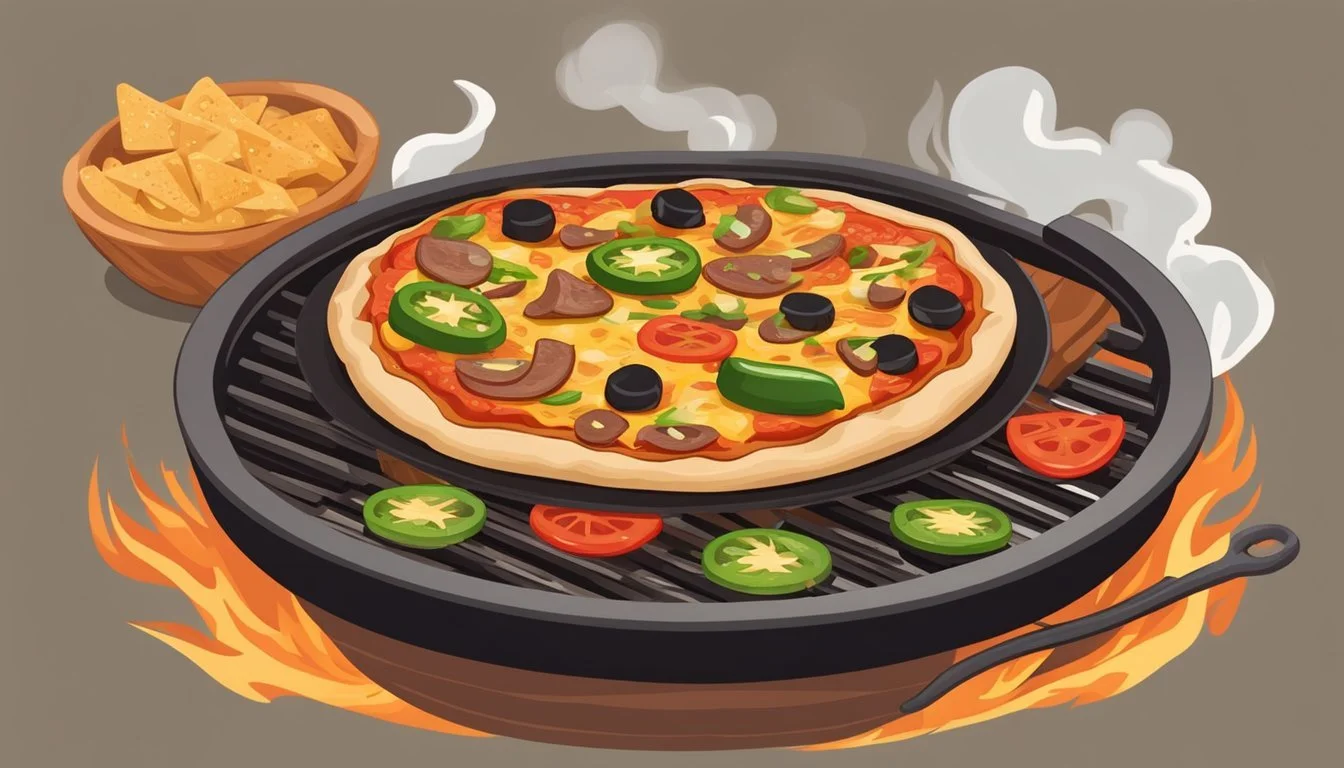How to Make a Texas-Style Grilled Pizza
Your Ultimate Guide
Grilled pizza (What wine goes well with pizza?) offers a delightful twist to the traditional oven-baked variety, and when it comes to capturing the essence of bold flavors, Texas-style grilled pizza stands out. Embracing the principles of Texan barbecue, this style of pizza is characterized by its robust, smoky flavors (What wine goes well with smoky flavors?) and hearty toppings. The high, direct heat of the grill mirrors the intense inferno of professional pizza ovens, creating a crisp, aromatic crust that's hard to achieve with conventional home ovens.
Making a Texas-style grilled pizza involves a fusion of classic Italian technique with the big and bold taste that Texas is known for. The process commences with a dough stretched to the desired thinness, taking on a rustic, hand-formed shape that adds to its artisanal quality. Preparation involves a grill preheated to a medium-high heat, which is essential for achieving the charred yet chewy crust synonymous with grilled pizzas.
As for toppings, one can expect a Texas-style grilled pizza to feature a wide array of ingredients from spicy chorizo and barbecued meats (What wine goes well with barbecued meats?) to sweet peppers and tangy sauces, all designed to stand up to the intense heat of the grill. Cheese such as smoked mozzarella or cheddar often finds its way onto these pizzas, melting into a smoky layer that complements the grill's heat. The result is a uniquely Texan pizza experience that is as satisfying to make as it is to eat.
Selecting Ingredients
Selecting top-quality ingredients is essential for crafting an authentic Texas-style grilled pizza. The choice of cheese, toppings, and the preparation of your chicken, as well as creating your own BBQ sauce, will define the flavors and success of your pizza.
Choosing the Right Cheese
For a genuine Texas-style flavor, a blend of shredded mozzarella, smoked gouda, and sharp cheddar cheese is recommended. Mozzarella offers the classic pizza stretch, while gouda provides a smoky depth, and cheddar brings a touch of sharpness to balance the overall profile.
Mozzarella: Base cheese for stretch and mild flavor.
Gouda: To infuse a smoky note.
Cheddar: For a sharp, tangy taste.
Optimal Toppings for BBQ Pizza
When considering toppings for a Texas-style BBQ pizza, think hearty and flavorful. A combination of red onion, bell peppers, and peppers adds a mix of sweetness and a slight kick which complements the rich BBQ taste. Drizzle olive oil lightly on vegetables to enhance their natural flavor upon grilling.
Vegetables: Sliced red onions, diced bell peppers, and a selection of peppers.
Olive oil: A light drizzle on the vegetables before grilling to elevate flavor.
Preparing Your Chicken
Rotisserie chicken is an excellent choice for its convenience and succulent texture. Shred the chicken and mix it with a touch of BBQ sauce to ensure each piece is coated and flavorful, making it ready to be layered onto the pizza beautifully.
Chicken: Shred a rotisserie chicken into bite-sized pieces.
Mix with BBQ sauce: Ensure chicken is well coated for maximum flavor.
Making Homemade BBQ Sauce
Creating a homemade BBQ sauce gives you control over the flavor and sweetness. Start with a base of tomato sauce and add ingredients such as brown sugar, vinegar, Worcestershire sauce, and spices. Simmer until thickened for a sauce that's both tangy and slightly sweet, perfect for complementing the grilled pizza.
Base: Begin with tomato sauce.
Sweetener and Spices: Add brown sugar, vinegar, and preferred spices to taste.
Each ingredient should be selected carefully, ensuring fresh, high-quality components to bring out the best in your Texas-style grilled pizza.
Crafting the Perfect Dough
Crafting the perfect dough is the foundation of an exceptional Texas-style grilled pizza. Whether starting from scratch or using a store-bought base, attention to detail will ensure a crust that's the right mix of chewy and crisp.
Homemade Pizza Dough Basics
For homemade pizza dough, one begins with a basic recipe that involves five key ingredients: water, yeast, flour, oil, and salt. The yeast must first be dissolved in warm water, a crucial step to activate the rising agent. Once dissolved, it should appear slightly frothy, indicating the yeast is active. Following this, the addition of olive oil provides moisture and richness, while the combining of flour creates the structure of the dough. A pinch of salt enhances flavor and controls yeast activity. The ingredients are mixed to form a shaggy mass.
Mixing: Knead the mixture for 6-8 minutes by hand or in a stand mixer with a dough hook attachment on low speed. A properly kneaded dough should be elastic and smooth.
Rising: The dough needs to rise in a warm, draft-free area until it doubles in size, which typically takes about 1-1.5 hours. The dough's readiness can be checked by lightly pressing a finger into it. If the indentation remains, the dough is ready for the next step.
Shaping: Punch down the risen dough to release excess air bubbles, then divide and shape into balls. Let them rest for a few minutes before rolling or stretching into the desired thickness. Thin dough is ideal for a crisp crust typical of Texas-style grilled pizza.
Handling Store-Bought Dough
When opting for store-bought pizza dough, a few key steps can elevate its quality:
Bringing to Temperature: Let the dough rest at room temperature for 20-30 minutes before shaping. Cold dough is more difficult to work with and won't stretch as easily.
Pre-Shaping: Gently stretch and fold the dough to form a tight ball, then allow it to rest once more. This process redistributes the yeast, allowing for an even rise and creating a more uniform texture.
Once the dough, homemade or store-bought, is ready, one can proceed to grill. Grilling imparts a smoky flavor and a unique crispiness to the crust, making it a standout choice for pizza enthusiasts. The grilling time is brief, so one must prepare the toppings in advance and be ready to assemble quickly on the grill for that perfect Texas-style grilled pizza.
Prepping the BBQ Chicken
When creating Texas-style grilled pizza, the BBQ chicken is a centerpiece ingredient. Ensuring it's prepared with care will infuse your pizza with authentic, smoky flavor.
Using Rotisserie Chicken
For those seeking convenience while still aiming for flavor, rotisserie chicken is an excellent time-saving option. To use, one should:
Purchase a precooked rotisserie chicken.
Let it cool slightly for handling.
Shred the chicken into bite-sized pieces.
Remember to discard the skin and bones. The shredded chicken will later be tossed with homemade BBQ sauce before being evenly distributed atop the pizza.
Marinating and Grilling Chicken
If you opt for freshly grilled chicken, begin with boneless chicken breasts. These steps will ensure a richly flavored element for your pizza:
Marinate the chicken: Combine the following in a bowl for your marinade:
1/4 cup brown sugar
1 tablespoon paprika
Salt and pepper to taste
Coat the chicken thoroughly and let it marinate for at least 30 minutes, or up to 24 hours in the refrigerator.
Preheat your grill to medium-high temperature.
Grill the chicken until it reaches an internal temperature of 165°F, usually taking about 6 to 8 minutes per side depending on thickness.
Once cooled slightly, chop or shred the grilled chicken.
Toss the grilled chicken with homemade BBQ sauce to integrate the flavors before layering it on the pizza dough. This not only adds moisture but also ensures every bite of your BBQ chicken pizza is packed with taste.
Seasoning and Sauces
When making a Texas-style grilled pizza, one's choice of seasonings and sauces can elevate the dish, adding layers of flavor and a signature smoky profile. A careful selection of herbs and a rich BBQ sauce are integral to achieving the authentic Texas taste.
The Role of Herbs and Spices
In Texas-style cuisine, herbs such as cilantro, parsley, and basil play pivotal roles in imbuing food with its characteristic zest. For grilled pizza, one should consider a blend of these fresh herbs to create a dynamic flavor profile. Specifically, fresh cilantro adds a unique, citrus-like touch that complements the smokiness of the grill, whereas parsley offers a subtle bitter note. Basil contributes a sweet and peppery flavor that marries well with traditional pizza toppings. (What wine goes well with pizza toppings?)
Cilantro: Citrus-like flavor, used as a garnish or mixed into sauces.
Parsley: Bitter notes, finely chopped for scattering over the pizza.
Basil: Sweet and peppery, often used fresh but can also be incorporated in the pizza sauce.
Choosing a BBQ Sauce
The selection of BBQ sauce is critical in crafting a Texas-style grilled pizza. A tangy BBQ sauce, possibly with a hint of sweetness, is traditionally favored. It should be thick enough to cling to the crust and toppings while also adding a sticky, caramelized texture as it grills. For those mindful of their diet, the calories in the sauce can be a consideration; however, for full flavor, a regular BBQ sauce is recommended. One could also craft a homemade BBQ sauce, adjusting the levels of tanginess and sweetness to personal taste.
BBQ Sauce: Tangy and sweet, acts as a pizza base or a drizzle.
Calories: Consider using a lighter sauce for a less calorific option.
To further personalize the sauce, one could drizzle a bit of olive oil over the pizza immediately after grilling, adding a subtle richness that rounds out the sharp flavors of the BBQ sauce. The fusion of a thoughtfully chosen BBQ sauce and an aromatic herb mix will make the Texas-style grilled pizza a memorable culinary experience.
Assembling the Pizza
When crafting a Texas-style grilled pizza, the assembly is crucial to achieving the perfect balance of flavors and textures. Operators will layer ingredients meticulously, respecting the cooking properties of each component.
Layering Ingredients on the Dough
One should begin by spreading a thin layer of sauce over the dough, leaving a small border for the crust. The foundations of the pizza are built here, with toppings strategically placed to ensure even cooking and distribution. For meats like pepperoni and bacon, the cook will need to scatter them uniformly, as they're key to Texas-style pizza's hearty profile. Following the meat, mozzarella cheese acts as a delicious binder for all ingredients. Below is a suggested order of layering:
Pepperoni: Evenly spaced for full coverage.
Bacon: Cooked beforehand and crumbled.
Bell Pepper: Sliced into thin strips for a quick cook.
Red Onions: Finely chopped or thinly sliced for a milder flavor.
Mozzarella Cheese: Generously sprinkled to cover the toppings.
Applying these toppings in layers maximizes texture contrast—crispy pepperoni edges against the soft melt of cheese and the crunch of veggies.
Drizzling Sauces and Adding Spices
Once the pizza is populated with toppings, one shall finish with a modest drizzle of sauce if needed, and a careful selection of spices that complement the profile of a Texas-style pizza. Spices such as smoked paprika or chili flakes may be added for a subtle kick, while a finishing touch of fresh, chopped herbs could be reserved for after grilling. Chefs should consider the following approach to finalizing flavors:
Sauce drizzle (optional): If desired, lightly drizzle with barbecue or hot sauce.
Spices and herbs:
Smoked Paprika: A dash for a smoky flavor.
Chili Flakes: Sprinkled lightly for heat.
Fresh Herbs: Such as cilantro, added post-grill for vibrancy.
The pizza assembler can now proceed with confidence to grill the pizza, knowing that the layers have been optimally crafted for a Texas-style feast.
Grilling Techniques
When grilling Texas-style pizza, one must ensure the use of proper techniques for utilizing a pizza stone and achieving the crispy crust that is synonymous with great grilled pizza.
Using a Pizza Stone on the Grill
To begin, they must prepare their grill for a pizza stone by heating it to a high temperature, typically around 500°F. It is crucial for them to place the pizza stone on the grill before it heats up to avoid thermal shock, which can result in cracking the stone. Once the grill and stone are adequately heated, they can slide the pizza onto the stone using a baking sheet or a pizza peel for an evenly cooked, crispy base.
Preheating the Grill: Heat the grill with the pizza stone on it to 500°F.
Sliding the Pizza: Use a baking sheet or peel to move the pizza onto the heated stone.
Achieving a Crispy Crust
For the perfect Texas-style pizza, one aims for a crust that's both chewy and crisp. They achieve this by first grilling one side of the pizza dough until it's got a lightly charred texture. After flipping it, they should work quickly to apply their toppings. The grill's intense heat mimics the effects of a professional pizza oven, which crisps the bottom while keeping the toppings juicy and flavorful.
Grill One Side: Place dough on the grill until lightly charred, then flip.
Add Toppings Quickly: Top the pizza rapidly to prevent heat loss and ensure a crispy crust.
When part of The Grill Squad, their techniques reflect their expertise in managing the grill's temperature and optimizing it for pizza. They must stay vigilant and adjust the heat as needed to ensure a well-cooked pizza without burning it. A successful grilled pizza sports a crispy crust, marking the prowess of the griller in achieving that sought-after texture.
Serving and Presentation
When the Texas-style grilled pizza is ready, presentation plays as much of a role as the smoky flavors do in amplifying the dining experience. One must handle the visuals of melted cheese and the practicality of serving with equal importance.
Cutting and Plating
After cooking, one should allow the pizza to cool for about 5-10 minutes. This rest period lets the cheeses, ranging from fresh mozzarella to smoked gouda, set slightly to ensure they don't slide off during cutting. Utilizing a pizza cutter or a sharp knife, the pizza should be sliced into even portions, traditionally in triangles, to maintain consistent serving sizes. Each slice can range from 200 to 300 calories, so portion size is key for nutritional consideration. It’s generally suggested to serve directly on a cutting board for a rustic, inviting display.
Garnishing Your Pizza
A final touch of culinary finesse involves garnishing the pizza which, depending on preference, can enhance both flavor and appearance. A light sprinkle of Parmesan cheese offers a salty, umami quality and a dusting of herbs can add both color and freshness. For a Texas twist, one could add a drizzle of barbeque sauce or a sprinkle of chili flakes to pay homage to the state’s love for heat and smoky flavors. The melted cheese, be it a golden layer of gouda or the creamy stretches of fresh mozzarella, provides a visually appealing base that welcomes additional toppings or garnishes.
Nutritional Information
When considering the nutritional content of a Texas-Style Grilled Pizza, it is essential to account for each component that makes up the dish. The following is a typical nutritional breakdown for a standard slice of Texas-Style Grilled Pizza, which can vary based on the specific ingredients and portion sizes used:
Calories: A slice typically ranges from 250 to 350 calories, depending on the toppings and cheese used.
The crust, often made from a simple combination of flour, water, yeast, and oil, provides a significant portion of the calories—mainly from carbohydrates. Toppings like cheese add not only flavor but also a notable amount of fat and protein.
Key Nutrients (per slice):
Carbohydrates: Approx. 30-40g
Proteins: Approx. 10-15g
Fats: Approx. 10-20g
Sodium: Varies widely based on toppings and sauce used.
Meats such as sausage or pepperoni commonly found on a Texas-Style Grilled Pizza are sources of protein but also contribute saturated fat and sodium. Vegetables can add fiber with minimal calories.
Nutritional Components Table:
Nutrient Quantity (per slice) Calories 250-350 Carbohydrates 30-40g Proteins 10-15g Fats 10-20g Sodium Varies
It is significant to note that individual dietary needs vary and consulting a nutritionist or dietitian for personalized advice is beneficial. Additionally, for those watching their caloric intake or specific nutrients, variations in ingredients—for instance, using a whole wheat crust, low-fat cheese, or more vegetables—can offer a healthier option without sacrificing flavor.
Additional Toppings and Variations
Texas-style grilled pizza can be a canvas for a variety of toppings beyond the classic combinations. These can range from traditional to bold, allowing for a personalized touch that suits any preference or dietary requirement.
Vegetarian Options
Vegetarians can take pleasure in the smoky flavors of the grill without compromising their dietary choices, as grilled pizza provides an excellent opportunity to showcase a range of garden-fresh vegetables. Bell peppers and mushrooms present a substantial texture and a hearty taste, while jalapeños add a Texas-sized kick. For a sweeter note, slices of pineapple can be interspersed among other toppings to create an intriguing contrast with the savory elements. One can also scatter corn kernels for a pop of sweetness that echoes the flavors of the state's beloved corn dishes.
Bell peppers (sliced)
Mushrooms (sliced)
Jalapeños (diced)
Corn (kernels)
Pineapple (chunks)
Alternative Meats and Cheeses
For those seeking to deviate from traditional toppings like pepperoni, Texas-style throws the door wide open to a variety of meats. Smoked brisket or spicy chorizo can replace or accompany pepperoni to reflect Texan flavors. Additionally, bacon can add a crunch and a smoked undertone that complements the fire-grilled crust. When it comes to cheese, one might opt for a blend of sharp cheddar with Monterey Jack, substituting the usual mozzarella for a taste that's deeply rooted in Texan cuisine.
Meats: Smoked brisket, spicy chorizo, bacon strips
Cheeses: Cheddar, Monterey Jack
By incorporating these additional toppings and variations, individuals can craft a Texas-style grilled pizza that's both unique and reflective of the rich culinary heritage of the Lone Star State.
Engaging with the Community
When making a Texas-Style Grilled Pizza, a chef can enhance their experience by sharing their culinary journey with others and connecting with fellow grill enthusiasts. Social media platforms and community groups offer valuable spaces for interaction and learning.
Sharing on Social Media
Chefs can showcase their Texas-Style Grilled Pizza creations on platforms such as Instagram and Facebook. By posting high-quality images of their pizza, detailing the grilling process, and using targeted hashtags, they can reach a wider audience. For Instagram, captions with step-by-step highlights and stories with polls or Q&A can encourage engagement.
Instagram:
Post images: Share visually appealing photos of the grilled pizza, using hashtags like #GrilledPizza, #TexasStylePizza.
Stories interaction: Use features such as polls, Q&A, or "Swipe Up" to share recipes and engage followers.
Facebook:
Create posts: Share the experience and encourage discussions by posting pictures and asking for feedback.
Groups: Join groups such as "The Grill Squad" to exchange tips with other enthusiasts.
Connecting with Grill Enthusiasts
Connecting with grill enthusiasts on social media groups and at local events can provide support and inspiration. Members of "The Grill Squad" on Facebook can benefit from shared knowledge on grilling techniques specific to the Texas-Style Grilled Pizza. Attending local grilling events or contests can also offer opportunities to learn from more experienced grillers and showcase one's own skills.
The Grill Squad:
Participate in discussions: Offer advice and learn new techniques from the community.
Share stories: Engage with the community by sharing personal grilling anecdotes and experiences.
Local Events:
Participation: Attend local grilling contests and meet-ups to demonstrate grilling skills and learn from others.
Networking: Use these events to build connections with fellow grill enthusiasts and expand one's grilling repertoire.
Meal Prep and Storage Tips
Proper storage is essential for maintaining the freshness and flavor of Texas-style grilled pizza. By following these guidelines, one can enjoy delicious pizza even on busy days.
Storing Leftovers
Leftover pizza should be stored in an airtight container in the refrigerator. It will remain fresh for up to 4 days. To retain the best quality, one should ensure that the pizza cools down to room temperature before refrigerating to prevent condensation that can lead to a soggy crust.
Refrigerator Storage: Up to 4 days in an airtight container
Conditions: Cool to room temperature before refrigerating
Freezing and Reheating Instructions
To freeze Texas-style grilled pizza, one should first allow the pizza to cool completely. Once cooled, it can be wrapped in plastic wrap and placed in a freezer bag to avoid freezer burn. Frozen pizza can last up to 3 months when stored properly.
Freezer Storage: Up to 3 months
Packaging: Plastic wrap and freezer bag
Reheating Instructions: For best results, reheat the pizza in the oven or on the grill to recapture the crispiness of the crust.
Preheat the oven or grill to 375°F (190°C).
Place the pizza on a baking sheet or directly on the grill.
Heat for 5-10 minutes or until the cheese is bubbly and the crust regains its crispness.
Oven/Grill Temp: 375°F (190°C)
Time: 5-10 minutes
Time and Servings
For a Texas-style grilled pizza, timing and portioning are integral to the cooking process. Below is the breakdown of preparation, cooking, and total time required, as well as the servings it yields.
Prep Time: The preparation time is typically about 30 minutes, which covers making the dough if not store-bought, preparing toppings, and setting up the grill.
Cook Time: The cook time for a Texas-style grilled pizza is relatively quick due to the high heat of the grill. Each pizza will take approximately 2-3 minutes per side to achieve a crisp crust with a slightly chewy center.
Total Time: Combining both prep and cook time, one can expect to spend around 35-40 minutes from start to finish. However, this can vary slightly depending on individual grill temperatures and specific toppings used.
Servings: The standard recipe typically yields about 4 servings if one is making a large pizza or 4 individual-sized pizzas. This can be scaled up or down depending on the number of guests.
Entity Time/Servings Prep Time 30 minutes Cook Time 2-3 minutes/pizza Total Time ~35-40 minutes Servings 4 servings
One should ensure that they allocate sufficient time for the grill to preheat to an optimal temperature, which is a crucial step in achieving the perfect Texas-style crunch.
Popular Pairings and Sides
When it comes to enhancing the flavors of Texas-style grilled pizza, certain pairings and sides can elevate the dining experience. These accompaniments should complement the smoky flavors of the pizza and can vary from savory dishes to zesty dips.
Complementary Dishes
The bold taste of a Texas-style grilled pizza pairs well with sides that can stand up to its robust flavors. Here are some ideal side dishes:
Grilled Vegetables: (What wine goes well with grilled vegetables?)They add a hint of char and earthy notes that mirror the smokiness of the pizza.
Jalapeno Cheddar Cornbread: The spiciness of jalapenos and the richness of cheddar cheese enhance the overall flavor profile.
Crispy Southern Fried Okra: Its crunchy texture contrasts with the chewiness of the pizza crust.
Perfect Pizza Dips
Dips are the secret to adding moisture and creating a full flavor experience with each bite of grilled pizza. Consider these options:
Creamy Ranch Dressing: Ideal for drizzling or dipping, adding a cool and herby touch.
Authentic Texas Barbecue Sauce: Smother a slice for a sweet, tangy, and smoky kick.
Buttermilk Dill Sauce: Offers a tangy and refreshing dip that pairs well with spicy pizza toppings.
Whether it's the smoky vegetables or the bold barbecue sauce, each side and dip offers a unique addition to the pizza, ensuring a well-rounded Texan feast.
Conclusion
Grilled pizza, especially when one opts for a Texas twist, brings an extraordinary combination of flavors and textures to the table. A homemade pizza transitions from tradition to innovation when one takes it outside to the grill. The high heat of the grill ensures a superbly crisp crust that is difficult to replicate in a conventional oven.
For a specific treat like a homemade BBQ chicken pizza, the grilling process adds a smoky depth that complements the barbecue sauce. It's integral to prepare the pizza dough in smaller portions so everyone can enjoy a personal touch with their preferred thickness and size. Grilling each side of the dough before adding toppings ensures an even cook and satisfying crunch.
Following these steps, one achieves the ideal balance between a chewy dough and a crisp crust, with the medley of delectable toppings that are singed to perfection. Grillers should remember to:
Preheat the grill to emulate a pizza oven environment
Brush the dough with oil for a crispy finish
Be attentive to cooking times to prevent burning
Allow cooked pizza to rest before serving to enhance flavors and ease slicing
With a careful eye and a ready set of tongs, anyone can enjoy authentic Texas-style grilled pizza right in their backyard. Each bite reaffirms why this cooking method has garnered such acclaim.


